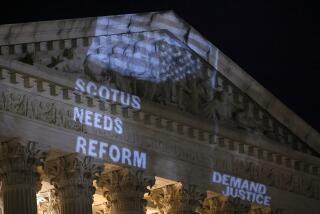Some Democrats want to rein in the filibuster
Reporting from Washington â The Senate filibuster has emerged as the bane of President Obamaâs legislative agenda, igniting anger among liberals over a tactic that is now hogtying Congress even on noncontroversial bills.
The threat of filibusters has become so common that congressional leaders take it for granted that any bill of consequence will not pass the 100-member Senate with a simple majority of 51. Instead, 60 votes -- the number needed to cut off the interminable speeches of a filibuster -- has become the minimum required.
Frustration has intensified since Senate Republicansâ no-holds-barred effort to block the healthcare bill. GOP use of the tactic forced Democrats to scrounge for 60 votes at every legislative turn to prevent filibusters.
Now, facing the prospect of losing seats in this fallâs midterm elections, some Democrats are seeking to change the rules.
While Democrats have large majorities in the House and Senate, the 60-vote threshold for action in the Senate has become a powerful curb on the scope of the Obama agenda. To prevail over united Republicans, all 58 Democrats, including a small but influential faction of conservatives, have to stick together, along with the Senateâs two independents.
The Democratsâ vulnerability could be even greater given the announcements of Sens. Christopher J. Dodd (D-Conn.) and Byron L. Dorgan (D-N.D.) that they will not run for reelection this year.
The demands of hitting that 60-vote bar have dashed liberal hopes of including in the healthcare bill a new government insurance option to compete with private companies. Earlier last year, filibuster threats from Republicans and conservative Democrats in effect forced Obama to accept a smaller economic stimulus bill than many Democrats wanted. Obamaâs Senate allies have been hard-pressed to round up 60 votes for a major initiative to address global warming.
It is the Senateâs own rules, not the Constitution, that set 60 votes as the benchmark for cutting off debate. Sen. Tom Harkin (D-Iowa), chairman of the Senate health committee, argues that current rules have made it too hard for Democrats to exercise the mandate they received from the voters in 2008.
âElections should have consequences,â Harkin said in a recent letter to his colleagues urging a change in filibuster rules. âEven when a party loses, it too easily can prevent the majority elected to govern from legislating.â
Rep. Alan Grayson (D-Fla.) has launched a petition drive urging Senate Majority Leader Harry Reid (D-Nev.) to push for cutting from 60 to 55 the number of votes needed to cut off a filibuster.
âWhy should launching wars and cutting taxes for the rich require only 50 votes, while saving lives requires 60?â asked Grayson, who cited a number of major bills that were passed by the Senate with less than 60 votes while President George W. Bush was in office.
Democrats have used the filibuster against Republicans when the GOP was in the majority, most recently from 2001 to 2006. Back then, Democrats were great defenders of the right to filibuster Bushâs judicial nominations. At one point in 2003, Reid spent more than eight hours on the Senate floor protesting the fact that Republicans spent so much time on four disputed judges instead of on joblessness. Reid read six chapters from a book heâd written about his tiny hometown of Searchlight, Nev.
Today, Reid is the Senate majority leader and complains bitterly about GOP delaying tactics.
To make it easier to end a filibuster, Harkin has proposed gradually reducing the number of votes needed to cut off debate -- from 60 votes on the first attempt, to 57 votes if another vote is held two days later, and eventually to 51 votes if the debate drags on long enough.
âUnder this proposal, a determined minority could slow any bill down,â Harkin said in his recent letter to colleagues. âA minority of members, however, could not stymie the majority by grinding the Senate to a halt, as sadly too regularly happens today.â
But few senators show much inclination to tamper with a tool that gives enormous leverage to either party when it finds itself in the minority.
âItâs a real obstacle to getting much done, but itâs ingrained into the Senate,â said the Senateâs historian, Donald A. Ritchie. âItâs the institution the senators enacted themselves. They do have the power to change it.â
Some senatorsâ refusal to even consider changes infuriates Democrats in the House, where a simple majority prevails and debate is strictly limited. Frustrated liberals say that Senate rules are a relic of another era that hobbles Congressâ ability to address the nationâs problems.
The filibuster is rooted in the Senateâs tradition of allowing unlimited debate, which is intended to produce a more considered judgment on policy than in the House. The Senate did not allow for any debate limits until 1917, when a filibuster blocked legislation to allow merchant ships to be armed against German submarine attacks during World War I. Infuriated, President Wilson called the Senate back into session to pass the bill and adopt new procedures for cutting off filibusters.
The rule called for closing debate -- or invoking cloture -- by a vote of two-thirds of the senators present. That threshold was lowered to 60 votes in 1975 and remains today. That is why, in practice, a minority of 40 senators can keep legislation from coming to a vote.
The most renowned use of the filibuster was by Southern senators who blocked civil rights legislation for decades. That ended in 1964, when the Senate cut off a record 87-day filibuster against the Civil Rights Act, a turning point in the nationâs long struggle over outlawing racial discrimination. It marked the first time the Senate had been able to cut off the filibuster of a civil rights bill.
The storied filibusters of the 20th century were the all-night talkathons of legend, with senators reading recipes and the Constitution to hold the floor, and using urine bags so they did not have to take bathroom breaks. That image was cemented by Jimmy Stewartâs performance in the film âMr. Smith Goes to Washington,â in which he played a political rookie who filibustered against corrupt legislation until he collapsed.
Now, as House and Senate leaders are working with the White House to resolve differences between their two versions of the healthcare bill, the number 60 looms large over the talks.
To circumvent further delaying tactics, Democrats have decided not to name an official House-Senate conference committee to reconcile the billsâ differences -- because naming those conferees is just one more thing that Republicans could filibuster.
Instead, leaders of the two chambers will negotiate informally, then bring the compromise straight to the House and Senate floors.
More to Read
Get the L.A. Times Politics newsletter
Deeply reported insights into legislation, politics and policy from Sacramento, Washington and beyond. In your inbox three times per week.
You may occasionally receive promotional content from the Los Angeles Times.











